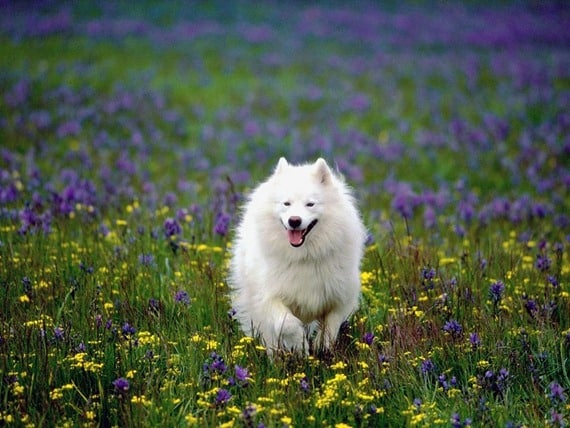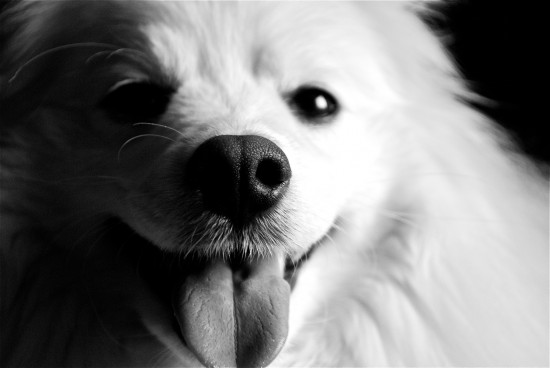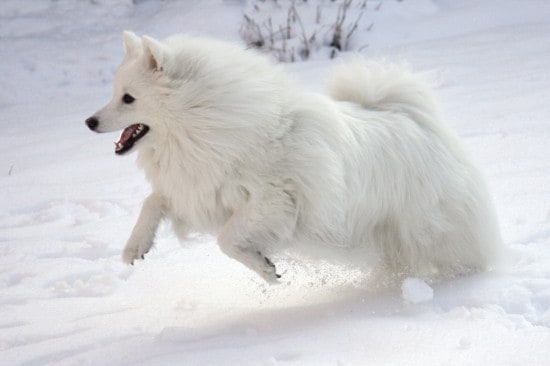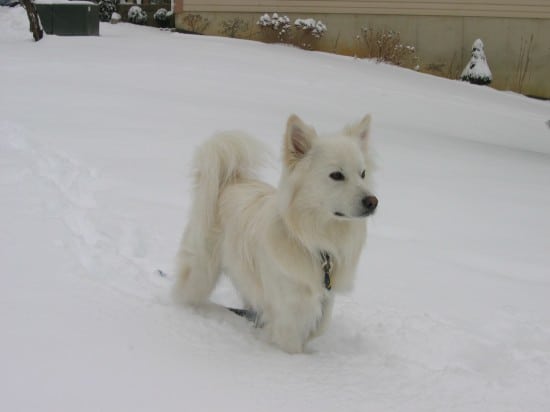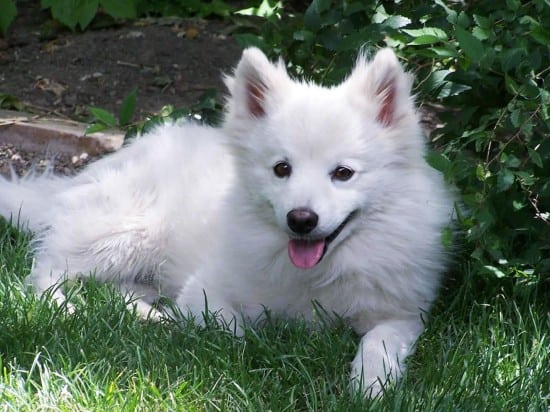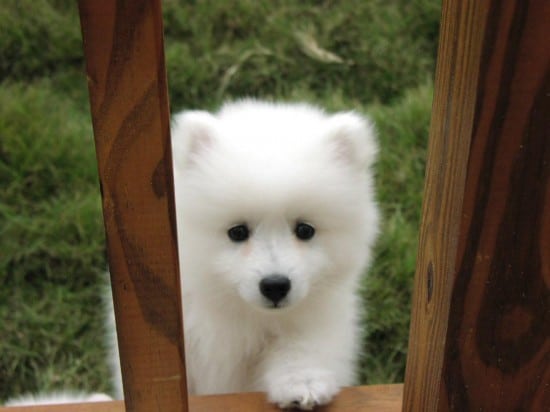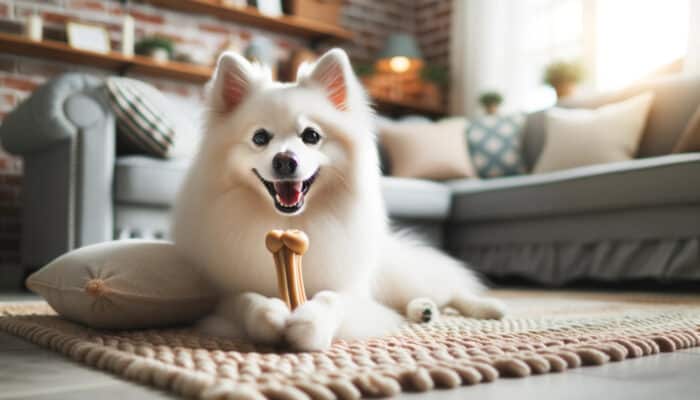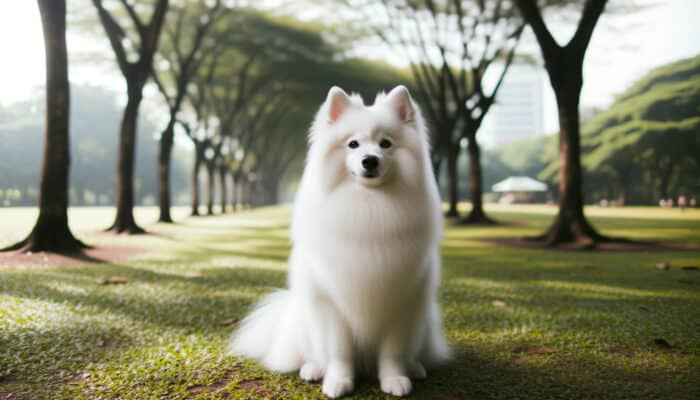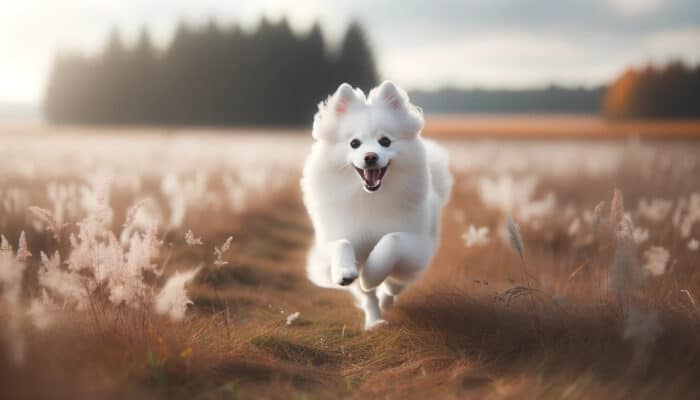The American Eskimo Dog, often referred to as the “Eskie,” is a breed known for its striking white coat and intelligent gaze. Popular in the United States, this breed stands out for its intelligence and family-friendly nature.
With its medium size and fluffy appearance, the American Eskimo Dog is a favorite in many households, particularly in North America. Renowned for its agility and friendly demeanor, it also possesses distinct characteristics that make it unique among other breeds.
Intelligence & Temperament: American Eskimo Dogs are highly intelligent, easy to train, and generally friendly. Their vocal nature makes them good watchdogs.
Grooming Needs: Their beautiful white coat necessitates regular grooming, including frequent brushing to prevent matting.
Health Considerations: Eskies may face health issues like hip dysplasia and progressive retinal atrophy. Regular vet visits are essential for early detection and management.
Exercise & Activity: These active dogs require consistent exercise and thrive in settings where they can run and play.
American Eskimo Dog Breed – Quick Facts
| Feature | Description |
|---|---|
| Size | Medium; Height: 15-19 inches (38-48 cm) |
| Weight Range | 20-40 pounds (9-18 kg); Slight differences between males and females |
| Predominant Colors | White, Biscuit Cream |
| Fur Length and Type | Medium; Straight |
| Lifespan | 12-15 years |
| Activity Level | Moderate |
| Intelligence Level | High |
| Ease of Training | Average |
| Good with Kids | Yes, with supervision |
| Training Requirements | Standard |
| Known Health Issues | Progressive Retinal Atrophy, Hip Dysplasia, Legg-Calvé-Perthes Disease |
Physical Characteristics of the American Eskimo Dog
The American Eskimo Dog boasts a medium stature, typically standing between 15 to 19 inches tall (38-48 cm). Males generally weigh slightly more than females, with weights ranging from 20 to 40 pounds (9-18 kg). The breed has a well-proportioned build, neither too lean nor overly muscular.
The Eskie’s coat is one of its most distinguishing features. It has a medium length, straight fur that radiates a pristine white or biscuit cream color. This dense double coat provides insulation against cold weather, making them well-suited for cooler climates.
When observing the face of an American Eskimo Dog, you’ll note its wedge-shaped muzzle and alert, expressive eyes. The eyes often portray a keen intelligence, always eager to engage. Their triangular ears stand erect, adding to their attentive appearance.
While the breed’s uniform color is its hallmark, some Eskies might have biscuit cream markings, especially around the ears or on the back.
Their gait is agile and balanced, displaying both strength and grace, reflecting their history as working dogs in various capacities.
American Eskimo Dog Temperament & Personality
The American Eskimo Dog is often characterized by its friendly and alert nature. Their keen intelligence and natural curiosity make them attentive to their surroundings, always eager to learn and engage. This breed is generally amiable, making it a good fit for families.
When it comes to interactions, Eskies usually get along well with people, other dogs, and animals. They tend to be sociable, but their approach might vary from one dog to another. Some might be instantly friendly, while others could be a bit reserved at first.
Training sessions with an American Eskimo Dog can be rewarding. Their intelligence shines through, and they’re generally eager to please their owners. However, their independent streak might sometimes require a bit more patience during training.
Eskies possess moderate energy levels. Regular exercise is essential for them to maintain their physical and mental health. A good balance of play and relaxation suits them best.
Adaptability is another trait of the American Eskimo Dog. They can adjust to various living situations. In family settings, they usually blend in well, appreciating the company of both adults and children.
However, supervision is advisable when they’re around very young kids. Their interaction with other pets is generally positive, but early socialization always helps in fostering amicable relations.
What Does The Ideal Home For an American Eskimo Dog Look Like?
For an American Eskimo Dog to thrive, certain environmental considerations are crucial. While they can adapt to various living spaces, a home with a decent-sized backyard is ideal. This allows them room to play and exercise. If a backyard is available, secure fencing is essential to ensure their safety, as their curiosity might lead them to explore.
The breed fits well in various family dynamics. They’re generally good with children, making them suitable for households with younger members. However, supervision is advised, especially with toddlers. The presence of elderly members or other pets usually isn’t an issue, as Eskies are known for their adaptable nature.
Considering their moderate energy levels, having spaces where they can engage in physical activities is beneficial. This could include a garden area, a nearby park, or a dedicated play space within the home. While they aren’t overly demanding in terms of exercise, regular play sessions help keep them mentally and physically stimulated.
It’s also important to note the breed’s sensitivity to extreme temperatures. American Eskimo Dogs have a dense coat that offers protection against the cold, making them more tolerant of cooler climates. However, during hot weather, it’s essential to provide them with a cool, shaded area to rest and ensure they have access to fresh water at all times. Their thick fur can make them prone to overheating, so monitoring them during hot spells is crucial.
Can American Eskimo Dogs be left alone?
When considering leaving an American Eskimo Dog alone, it’s essential to understand their temperament. Eskies are social creatures and thrive on companionship. While they can handle short periods of solitude, extended durations might lead to feelings of isolation or anxiety.
If left alone for too long, some might exhibit signs of separation anxiety, which can manifest in behaviors like excessive barking, destructive actions, or restlessness. However, with proper training and gradual conditioning, they can learn to be more independent.
It’s always advisable to ensure they have toys or activities to keep them engaged during your absence. Proper exercise before leaving them alone can also help in keeping them calm.
Ideal Owner for an American Eskimo Dog
The American Eskimo Dog, with its friendly nature and moderate energy levels, can be a joy to own. However, they’re best suited for someone who understands their unique needs and temperament.
While they’re adaptable, Eskies might pose some challenges for first-time dog owners. Their intelligence, combined with a hint of stubbornness, requires an owner who can provide consistent training. Someone with prior experience in dog training or handling can often navigate these challenges more smoothly.
The breed’s moderate energy level means they’re not just for active individuals. They fit well with owners who enjoy regular walks or play sessions but also appreciate relaxed evenings. However, a sedentary lifestyle without any activity is not ideal for them.
Training is a crucial aspect of raising an Eskie. The ideal owner should be committed to consistent training sessions, ensuring the dog learns manners and basic commands. Positive reinforcement methods work best with this breed.
Lastly, given their social nature, the American Eskimo Dog thrives on companionship. The ideal owner would spend quality time bonding, playing, and engaging in activities with the dog. Regular grooming is also a part of their care routine, so an owner willing to invest time in maintaining their pristine coat is a bonus.
Are American Eskimo Dogs good with kids?
American Eskimo Dogs generally have a positive disposition towards children. Their friendly and playful nature makes them suitable companions for kids.
However, like any breed, interactions between dogs and young children should always be supervised. While Eskies are tolerant and patient, it’s essential to teach children how to approach and handle dogs respectfully.
This ensures a harmonious relationship and minimizes any potential risks. Given proper introductions and guidance, American Eskimo Dogs can form lasting bonds with children, becoming protective and loyal family members.
Are American Eskimo Dogs aggressive?
The American Eskimo Dog is not typically aggressive by nature. They are, in general, friendly and eager to engage with people. However, like any breed, individual temperaments can vary. Some Eskies might be more reserved or cautious, especially around unfamiliar stimuli or new environments.
It’s essential to understand that any signs of aggression often stem from fear, lack of proper socialization, or past negative experiences. Early socialization, exposing the dog to various environments, people, and other animals, can help mitigate any aggressive tendencies.
If an Eskie displays signs of aggression, it’s crucial to identify any potential triggers. It could be a specific situation, object, or individual. Once identified, these triggers can be addressed through training and positive reinforcement, ensuring the dog feels safe and secure.
How Popular Is This Breed?
The American Eskimo Dog, often affectionately referred to as the “Eskie,” enjoys a steady popularity, especially in the United States. Historically, this breed was a favorite in American circuses during the early 20th century, showcasing their intelligence and agility. This exposure significantly boosted their popularity among the American public.
In the USA, the breed is especially favored for its striking appearance, friendly disposition, and adaptability to family life. Their moderate size and affable nature make them suitable for both suburban and urban settings. While their popularity might not be as vast as some other breeds, Eskies have a dedicated following and are cherished by many for their loyalty and companionship.
Outside the US, the breed is known but might not be as prevalent.
American Eskimo Dog Grooming
The pristine white or biscuit cream coat of the American Eskimo Dog is undoubtedly one of its standout features. However, maintaining its lustrous appearance requires regular grooming.
Brushing is an essential part of the Eskie’s grooming routine. Their dense double coat can become tangled or matted if not brushed regularly. It’s advisable to brush them at least two to three times a week to remove loose fur and prevent matting. A pin brush or slicker brush works well for this purpose. Regular brushing also helps in distributing natural oils, keeping the coat healthy and shiny.
Bathing should be done as needed, typically every couple of months or when the dog gets dirty. Using a gentle dog shampoo, specifically formulated for white coats, can help in maintaining their coat’s brightness. After bathing, it’s crucial to dry them thoroughly, ensuring no dampness remains in their thick fur, which could lead to skin issues.
While the American Eskimo Dog doesn’t require frequent haircuts, occasional trimming around the ears, feet, and hocks can give them a neat appearance. Their nails should also be trimmed regularly to prevent overgrowth and potential discomfort.
Professional grooming can be beneficial, especially during the Eskie’s shedding seasons. A professional groomer can provide a thorough brushing, removing any dead undercoat, and offer advice on maintaining their coat’s health and appearance.
Do American Eskimo Dogs shed?
Yes, American Eskimo Dogs do shed. Their dense double coat undergoes shedding, particularly during the transition from winter to spring and then again from summer to fall. During these periods, they shed their undercoat, which can result in a significant amount of loose fur.
Regular brushing, especially during shedding seasons, can help manage this shedding, collecting loose hairs and preventing them from accumulating in the home. While shedding is a natural process for the breed, ensuring a balanced diet and proper skin care can help in maintaining the health and quality of their coat, potentially reducing excessive shedding.
American Eskimo Dog Diet: What Do They Eat?
American Eskimo Dogs, like all breeds, have specific dietary needs to ensure optimal health and well-being. A balanced diet rich in essential nutrients is crucial for their active nature and to maintain their lustrous coat.
Eskies generally thrive on high-quality commercial dog food, which can be kibble, wet food, or even a raw diet. However, it’s vital to select food appropriate for their life stage, be it puppy, adult, or senior. As puppies, they might require food that supports their rapid growth, while seniors might benefit from diets formulated for joint health and lower calorie intake.
While commercial dog food provides a balanced diet, owners should be aware of any common allergies or sensitivities Eskies might exhibit. Some dogs might be allergic to grains or certain proteins. In such cases, grain-free or limited ingredient diets might be beneficial.
It’s also essential to provide treats in moderation. While treats can be beneficial for training purposes, excessive treats can lead to obesity. It’s crucial to select treats that are healthy and don’t contain fillers or artificial additives.
How to Feed an American Eskimo Dog
Feeding an American Eskimo Dog requires understanding their unique needs. Using a suitable bowl, preferably stainless steel or ceramic, is essential as these materials are easy to clean and do not harbor bacteria. Plastic bowls can sometimes cause allergies or skin irritations.
A consistent feeding routine is beneficial for the dog. Establishing set meal times, typically twice a day for adults, can aid digestion and set a predictable routine for the dog. It’s crucial not to leave food out all day, as it can lead to overeating and obesity.
For puppies, more frequent meals, three to four times a day, might be necessary due to their rapid growth and higher energy requirements. As they grow, the number of meals can be reduced.
Always ensure fresh water is available, refilling their water bowl multiple times a day and cleaning it regularly to prevent any bacterial buildup.
How Much to Feed an American Eskimo Dog
The amount to feed an American Eskimo Dog largely depends on their age, weight, activity level, and overall health. Here are some general guidelines:
For puppies up to six months, they typically require more calories due to their rapid growth. Depending on the specific food and its calorie content, a puppy might need anywhere from one to two cups of food divided into three to four meals a day.
Adult Eskies, depending on their size and activity level, usually consume between one to one and a half cups of high-quality dog food divided into two meals a day. Active dogs might require slightly more, while less active or older dogs might need less to maintain a healthy weight.
Health Considerations
American Eskimo Dogs, while generally healthy, do have some health concerns that potential and current owners should be aware of.
Hip dysplasia is one such concern common in many dog breeds, including the Eskie. This condition results from an improperly formed hip joint, leading to arthritis and pain. Regular check-ups and maintaining a healthy weight can help manage this condition.
Progressive Retinal Atrophy (PRA) is an eye condition that some Eskies might be predisposed to. It’s a degenerative eye disorder that eventually causes blindness. Early detection can help in managing the condition, although there’s no cure.
Another concern for the breed is Legg-Calve-Perthes disease, a condition where the blood supply to the femur is decreased, leading to joint issues.
The breed’s fluffy coat can sometimes hide skin issues or allergies, which might manifest as itching, redness, or even hair loss. Regular grooming and check-ups can help in early detection and treatment.
Despite these concerns, with proper care and regular veterinary check-ups, the American Eskimo Dog has a typical lifespan of 12 to 15 years. As they age, they might face common senior dog issues like arthritis or decreased vision. Providing them with a comfortable living environment, regular health check-ups, and a balanced diet can support them through their senior years, ensuring they remain active and healthy.
How much exercise do American Eskimo Dogs need?
American Eskimo Dogs are active and lively, requiring regular exercise to keep them mentally and physically stimulated. A daily routine of 30 to 60 minutes of moderate exercise is usually sufficient for most Eskies. This can be divided into walks, play sessions, or even agility training. Their intelligent nature makes them great candidates for agility courses or fetch games, which challenge them mentally as well.
While they enjoy outdoor activities, it’s essential to monitor them during extreme weather conditions, especially hot days, as their thick coat can make them prone to overheating. Providing them with a shaded area and fresh water during outdoor play is crucial.
It’s also worth noting that while physical exercise is important, mental stimulation is equally crucial for this breed. Puzzle toys, training sessions, or even hide-and-seek games can keep them engaged and prevent boredom-related behaviors.
American Eskimo Dog Training
Training is an essential aspect of raising an American Eskimo Dog. Given their intelligence and eagerness to please, Eskies can be a joy to train, but they also require consistency and positive reinforcement.
Starting training early is beneficial. As puppies, Eskies are more adaptable and can pick up basic commands like “sit,” “stay,” and “come” relatively quickly. Consistency is the key. Using the same commands and rewarding positive behavior with treats or praise helps reinforce learning.
Socialization is another crucial aspect of training. Early exposure to various environments, animals, and people fosters well-rounded social behaviors. This reduces the chances of them being overly shy or aggressive in unfamiliar situations. Puppy classes or regular visits to dog-friendly parks can provide opportunities for socialization.
Despite their intelligence, Eskies can sometimes exhibit stubbornness or independent behavior. This requires patience from the owner. Instead of using harsh methods, positive reinforcement techniques, like treats or praise for good behavior, prove more effective.
For those looking to challenge their Eskie further, advanced training in agility courses can be a great way to engage them. Their agility and intelligence make them good candidates for such activities.
House training is another area to focus on. Establishing a routine, like taking them out after meals or naps, and rewarding them for doing their business outside can aid the process. While accidents might occur, it’s important not to punish the dog but rather to reinforce the correct behavior.
Are American Eskimo Dogs easy to train?
American Eskimo Dogs are generally easy to train due to their intelligence and desire to please. They are quick learners and often pick up commands faster than many other breeds. However, their independent nature can sometimes make them a bit stubborn.
Consistency is the key to training an Eskie. It’s essential to establish clear boundaries and remain consistent in enforcing them. Positive reinforcement, such as treats or praise, works well with this breed, as they respond better to encouragement than to harsh methods.
Are American Eskimo Dogs smart dogs?
Yes, American Eskimo Dogs are considered smart dogs. They possess a high degree of intelligence, which is evident in their quick learning capabilities and problem-solving skills. Their aptitude extends beyond basic commands, as they can grasp complex tasks when trained consistently.
Their intelligence is not just limited to obedience training. Eskies have been known to exhibit problem-solving behaviors in their everyday lives. For instance, they might find innovative ways to reach a treat or toy, or understand patterns in the household routine, anticipating events.
What are the drawbacks of American Eskimo Dogs?
Owning an American Eskimo Dog comes with many joys, but there are also some challenges and drawbacks potential owners should be aware of:
Behavioral Challenges: While Eskies are generally friendly and sociable, they can be quite vocal. They have a tendency to bark, especially when they notice something unfamiliar in their environment. This trait makes them good watchdogs, but it can also be a nuisance in certain living situations, such as apartments or closely spaced homes.
Health and Genetic Issues: Like many purebred dogs, American Eskimo Dogs have some genetic health concerns. Hip dysplasia, progressive retinal atrophy, and Legg-Calve-Perthes disease are among the conditions to which they might be predisposed. Regular vet check-ups and being aware of these issues can help in early detection and management.
Grooming Requirements: Their beautiful, fluffy white coat requires regular grooming. Eskies need frequent brushing to prevent matting and tangling. Additionally, their coat can hide skin issues, which might go unnoticed without regular check-ups.
Exercise and Activity Needs: Eskies are active and require regular exercise. They thrive in environments where they can play and run. A sedentary lifestyle or lack of stimulation can lead to boredom-related behaviors like chewing or digging.
Specialized Care: While they are adaptable, American Eskimo Dogs might not be the best fit for very hot climates due to their thick coat. They also benefit from early socialization to become well-rounded dogs, as they can be reserved or wary around unfamiliar people or situations.
Popular American Eskimo Dog Mixed Breeds
Mixed breeds have gained popularity over the years for various reasons, ranging from health benefits to the desire for unique appearances or temperaments. The American Eskimo Dog, with its striking appearance and amiable nature, has been a choice breed for creating mixed breeds.
One common reason behind creating mixed breeds with the Eskie is to combine their friendly and intelligent temperament with traits from other breeds. This can lead to offspring that are both aesthetically pleasing and have a balanced personality.
Some popular American Eskimo Dog mixes include:
Eskie and Pomeranian mix (Eskiran): This mix often results in a small to medium-sized dog with a fluffy coat, inheriting the playful nature of the Pomeranian and the intelligence of the Eskie.
Eskie and Corgi mix (Eskicorgi): This combination often leads to a dog with short legs and a longer body. They tend to be energetic, smart, and have a friendly disposition.
Eskie and Shih Tzu mix (Eskitzu): This mix might produce a dog with a silky coat and a sweet, affectionate nature. They can be great companions for families.

